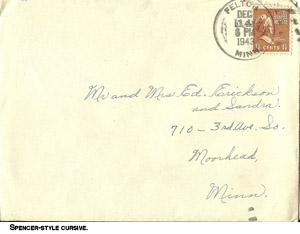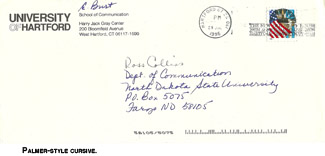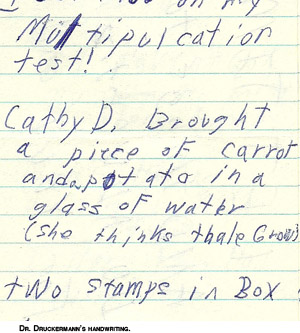The continuing adventures of Dr. Dan Druckermann, post-cyber historian of the twenty-second century.
Veterans and cursive.
 Professor Dan Druckermann took the day off for Veterans Day. It was a quiet, somber day. The president made her familiar solemn declaration against war. Repeated pointless wars of the late twentieth and early twenty-first century had nearly drove the country into receivership with China by 2050. After that the United States had overcome its fascination with military affairs, and had foresworn war save for self-defense. It was not for nothing that Dr. Druckermann's era of research was sometimes called the "Age of Armaments."
Professor Dan Druckermann took the day off for Veterans Day. It was a quiet, somber day. The president made her familiar solemn declaration against war. Repeated pointless wars of the late twentieth and early twenty-first century had nearly drove the country into receivership with China by 2050. After that the United States had overcome its fascination with military affairs, and had foresworn war save for self-defense. It was not for nothing that Dr. Druckermann's era of research was sometimes called the "Age of Armaments."
No one on this day found it necessary to thank a veteran. No veterans held military salutes or made patriotic pronouncements. This was because the United States no longer had any veterans. The last had died in 2090.
But Dr. Druckermann's great-great-grandfather was a veteran of a war fought in Vietnam. And so for his day away from the office the professor of twentieth century history decided to dust off a box that had come down to him through several generations of family packrats.
Dr. Druckermann pulled open the ancient cardboard flaps. The box itself was an antique. Faded letters stamped on its side made this container almost a collectible, spelling the name of the first company ever to market books on the internet: "Amazon.com." Its products had become obsolete nearly a century ago after most of the world abandoned manufacture of paper. But antiques survived.
Dr. Druckermann's great-great-grandfather Depp, named after an actor briefly popular during the era, had decided about 2010 to begin collecting letters and documents in cursive. "Cursive" was still common, although already becoming rare among young adults a century ago. In Dr. Druckermann's time, it had long become obsolete. The idea that grade schools should make space in their curriculum to teach penmanship died shortly after the idea that children should learn to do arithmetic by hand. Calculators had replaced pencils and paper more than a century ago. Soon no one could write cursive either. Soon after no one could write at all.
By 2110 handwriting as a form of communication was as dead as Latin had been to Dr. Druckermann's ancestors. Few people today could write it--save those Christo-Islamic monks laboring in cyber-scriptoriums to barely sustain a moribund art. But that wasn't what concerned Dr. Druckermann.
If few could write cursive, indeed, few could read it either. The attic collections of old letters, the valentine notes from long-dead classmates, the Christmas cards, and all the other wood-pulp detritus of the past had become as foreign to most modern eyes as Egyptian hieroglyphics. Today, if you wanted to read your ancestor's letters, you had to consult a specialist.
 Dr. Druckermann was just such a specialist. In high school his friends were signing up for the popular classes in Compiler English and Google Epistemology. Dr. Druckermann enrolled in Palmer Cursive. The Palmer method replaced Spencerian cursive in about 1920. It was less ornate, faster, easier to learn, and more attractive to a modern generation after World War I.
Dr. Druckermann was just such a specialist. In high school his friends were signing up for the popular classes in Compiler English and Google Epistemology. Dr. Druckermann enrolled in Palmer Cursive. The Palmer method replaced Spencerian cursive in about 1920. It was less ornate, faster, easier to learn, and more attractive to a modern generation after World War I.
Dr. Druckermann had to admit he had been quite a nerdy adolescent. Still, he learned to read Palmer, then Spencer, and now could read the letters in the box from his ancestor--in addition to making a fairly good side income as a free-lance translator of antique cursive.
The professor pulled out an ancient envelope with a stamp canceled in 1943. It was written in Spencerian cursive, done by a hand not particularly skilled. He easily read the cryptic scratching as a name and street address.
 Next he pulled out a letter from 1996--53 years later, yet still more than a century old. It was in Palmerian cursive. "Fairly ugly compared to Spencer's cursive," he mused. "But still elegant compared to today's handwriting."
Next he pulled out a letter from 1996--53 years later, yet still more than a century old. It was in Palmerian cursive. "Fairly ugly compared to Spencer's cursive," he mused. "But still elegant compared to today's handwriting."
Dr. Druckermann then pulled from his desk drawer a carefully tended object that looked like a pad of small paper sheets. In fact, it was called a notepad. A souvenir Dr. Druckermann picked up at an antique holo-shop. While paper in the twenty-second century had long become obsolete, it still was a fairly common and inexpensive find at flea markets and shops.
On this paper Dr. Druckermann had made some careful notes to himself. His script was considered quite sophisticated even for an educated man of his time. After all, most people could not hand write at all. Why learn to scratch letters onto paper when paper was rare? Dr. Druckermann's note did contain spelling errors, but that was to be expected. In real life, no one could spell: computers took care of that. Writing by hand was one of the few things beyond reach of a digitally dominated world.
It's a pity, thought Dr. Druckermann, that so few now could read cursive, this dead hand. George Washington's signature, the National Anthem of Francis Scott Key, Lincoln's Gettysburg Address; all these had been written in cursive. The treasures of democracy today had become as indecipherable as the the Magna Carta had been to the generations of a century ago. "Education ought to be practical, of course," mused Dr. Druckermann. "But sometimes in the archaic, the antiquated, the obsolete we touch a world long gone but a spirit still part of our lives."
He got up to see this year's Veterans Day pacifist parade. "And sometimes," he added, "obsolete generations remind us of the lessons they so painfully learned--and we must never forget."
 Professor Dan Druckermann took the day off for Veterans Day. It was a quiet, somber day. The president made her familiar solemn declaration against war. Repeated pointless wars of the late twentieth and early twenty-first century had nearly drove the country into receivership with China by 2050. After that the United States had overcome its fascination with military affairs, and had foresworn war save for self-defense. It was not for nothing that Dr. Druckermann's era of research was sometimes called the "Age of Armaments."
Professor Dan Druckermann took the day off for Veterans Day. It was a quiet, somber day. The president made her familiar solemn declaration against war. Repeated pointless wars of the late twentieth and early twenty-first century had nearly drove the country into receivership with China by 2050. After that the United States had overcome its fascination with military affairs, and had foresworn war save for self-defense. It was not for nothing that Dr. Druckermann's era of research was sometimes called the "Age of Armaments." Dr. Druckermann was just such a specialist. In high school his friends were signing up for the popular classes in Compiler English and Google Epistemology. Dr. Druckermann enrolled in Palmer Cursive. The Palmer method replaced Spencerian cursive in about 1920. It was less ornate, faster, easier to learn, and more attractive to a modern generation after World War I.
Dr. Druckermann was just such a specialist. In high school his friends were signing up for the popular classes in Compiler English and Google Epistemology. Dr. Druckermann enrolled in Palmer Cursive. The Palmer method replaced Spencerian cursive in about 1920. It was less ornate, faster, easier to learn, and more attractive to a modern generation after World War I.  Next he pulled out a letter from 1996--53 years later, yet still more than a century old. It was in Palmerian cursive. "Fairly ugly compared to Spencer's cursive," he mused. "But still elegant compared to today's handwriting."
Next he pulled out a letter from 1996--53 years later, yet still more than a century old. It was in Palmerian cursive. "Fairly ugly compared to Spencer's cursive," he mused. "But still elegant compared to today's handwriting."